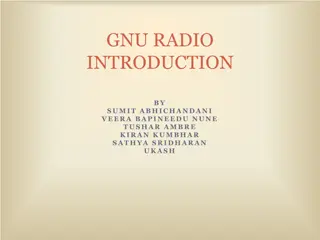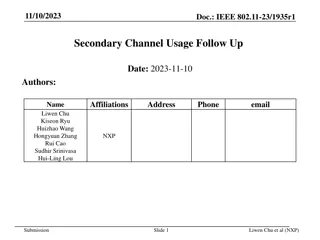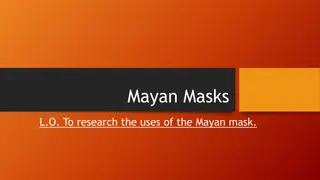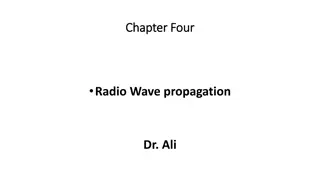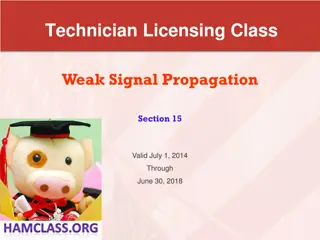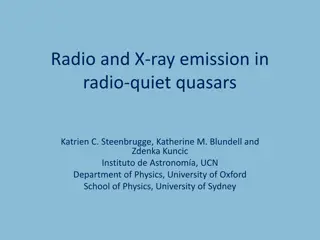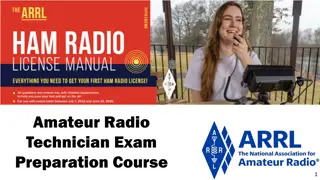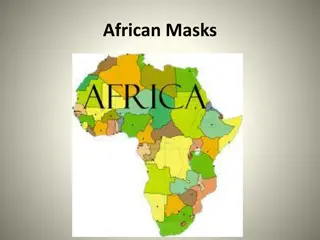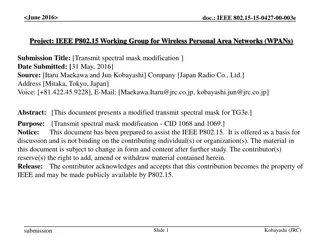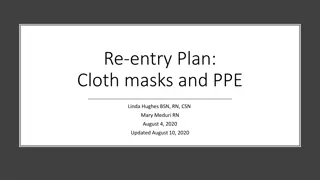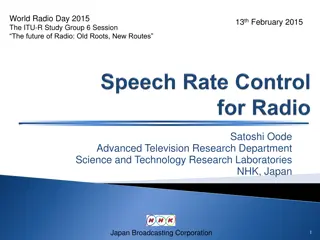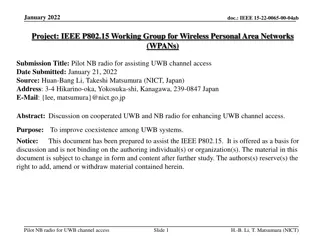
Interference Control for Next-Gen SUN PHYs in Japan
Explore the channel masks of radio channels for SUN PHYs in Japan, focusing on interference control with existing systems. Review the specifications in ARIB STD-T108 for Sub-1 GHz SUNs, addressing frequency bands, bandwidth, transmission power, and antenna gain requirements. This contribution discusses the implications for the standardization of Next Generation SUN PHYs and the need for effective interference management in wireless personal area networks.
Download Presentation

Please find below an Image/Link to download the presentation.
The content on the website is provided AS IS for your information and personal use only. It may not be sold, licensed, or shared on other websites without obtaining consent from the author. If you encounter any issues during the download, it is possible that the publisher has removed the file from their server.
You are allowed to download the files provided on this website for personal or commercial use, subject to the condition that they are used lawfully. All files are the property of their respective owners.
The content on the website is provided AS IS for your information and personal use only. It may not be sold, licensed, or shared on other websites without obtaining consent from the author.
E N D
Presentation Transcript
doc.: 15-24-0170-00-04ad Project: IEEE P802.15 Working Group for Wireless Personal Area Networks (WPANs) Submission Title: [Channel masks of radio channels for SUN PHYs in Japan] Date Submitted: 13 March, 2024 Source: Hiroshi Harada (Kyoto University) Address Yoshidahonmachi. Sakyo, Kyoto, 606-8501, Japan Voice: +81-75-753-5317 , E-Mail: hiroshi.harada@i.kyoto-u.ac.jp Re: [Wireless Next Generation, Long Range extension enhancements to 802.15.4-2020] Abstract: Introduce channel mask of a radio channel standardized by ATIB STD-T108 for the discussion on interference control. A part of this contribution was supported from the commissioned research (No.05101) by National Institute of Information and Communications Technology (NICT) , Japan. Purpose: Propose use for the new standardization of Next Generation SUN PHYs Notice: discussion and is not binding on the contributing individual(s) or organization(s). The material in this document is subject to change in form and content after further study. The contributor(s) reserve(s) the right to add, amend or withdraw material contained herein. Release: The contributor acknowledges and accepts that this contribution becomes the property of IEEE and may be made publicly available by P802.15. This document has been prepared to assist the IEEE P802.15. It is offered as a basis for Submission Slide 1 H. Harada (Kyoto University)
March 2024 doc.: 15-24-0170-00-04ad Channel mask of a radio channel in Japan March 13, 2024 Hiroshi Harada, Ph.D. Submission Slide 2 H. Harada (Kyoto University)
March 2024 doc.: 15-24-0170-00-04ad Background Next-generation SUN will require interference control with existing systems that use the same frequencies. FSK and OFDM, standardized in IEEE 802.15.4, are candidates for next- generation SUN. In particular, OFDM spectrum is widely distributed in its own band. In Japan, the ARIB, an SDO, defines the transmit power, operating frequency, and channel mask in ARIB STD-T108 for the SUN using Sub-1 GHz. This contribution document reviews the channel masks specified in this ARIB STD-T108 Submission Slide 3 H. Harada (Kyoto University)
March 2024 doc.: 15-24-0170-00-04ad Land Mobile Stations Frequency band: 920.5-922.3 MHz Bandwidth 200 n kHz (n=1,2,3,4,5) Transmission power 250 mW or less Antenna gain 3 dBi or less (absolute gain) However, in case EIRP is less than 27 dBm (the value of 3 dBi plus 250 mW of antenna power), it is allowed to fill in the gap by the antenna gain. Reference: ARIB STD T-108 Version 1.5 fc: Center frequency Submission Slide 4 H. Harada (Kyoto University)
March 2024 doc.: 15-24-0170-00-04ad Land Mobile Stations Frequency band: 922.3-923.5 MHz Bandwidth 200 n kHz (n=1,2,3,4,5) Transmission power 250 mW or less Antenna gain 3 dBi or less (absolute gain) However, in case EIRP is less than 27 dBm (the value of 3 dBi plus 250 mW of antenna power), it is allowed to fill in the gap by the antenna gain. Reference: ARIB STD T-108 Version 1.5 fc: Center frequency Submission Slide 5 H. Harada (Kyoto University)
March 2024 doc.: 15-24-0170-00-04ad Specified low-power radio stations Frequency band: 915.9-916.9 MHz, 920.5-929.7 MHz Bandwidth 200 n kHz (n=1-5): Center frequency: 916.0 - 916.8 MHz, 922.4 - 928.0 MHz: 1mW 100 n kHz (n=1-5): Center frequency: 928.15 - 929.65 MHz: 1mW 200 n kHz (n=1-10): Center frequency: 920.6 - 928.0 MHz: 20 mW it is prohibited to simultaneously use both the unit channels giving priority to prioritized passive tag system whose center frequencies are located from 920.6 MHz to 922.2 MHz and the unit channels whose center frequencies are located 922.4 MHz or more. Transmission power 20 mW or less. 1mW or less if radio channel in use includes 916.0 MHz -916.8 MHz or 928.15 MHz - 929.65 MHz Moreover, given the radio equipment is housed in a single cabinet and shall not be opened easily, and its EIRP is 16 dBm or 3 dBm or less (value when applying 20 mW or 1mW of antenna power to the transmitting antenna having absolute gain of 3 dBi), transmission power of 250 mW or less is allowed. Reference: ARIB STD T-108 Version 1.5 Submission Slide 6 H. Harada (Kyoto University)
March 2024 doc.: 15-24-0170-00-04ad Specified low-power radio stations Antenna gain 3 dBi or less (absolute gain) However, in case EIRP (Note) is more than 16 dBm or 3 dBm (value when applying 20 mW or 1 mW of antenna power to the transmitting antenna having absolute gain of 3 dBi), the excess amount should be reduced by the antenna gain and if it is 16 dBm or 3 dBm, and if it is 16 dBm or 3 dBm or less, it is allowed to fill in the gap by the antenna gain Reference: ARIB STD T-108 Version 1.5 Submission Slide 7 H. Harada (Kyoto University)
March 2024 doc.: 15-24-0170-00-04ad Specified low-power radio stations (915.9 MHz to 916.9 MHz, 1mW or less) Submission Slide 8 H. Harada (Kyoto University) Reference: ARIB STD T-108 Version 1.5
March 2024 doc.: 15-24-0170-00-04ad Specified low-power radio stations (920.5 MHz to 922.3 MHz, 20 mW or less) Submission Slide 9 H. Harada (Kyoto University) Reference: ARIB STD T-108 Version 1.5
March 2024 doc.: 15-24-0170-00-04ad Specified low-power radio stations (922.3 MHz to 928.1 MHz, 1 mW or less) Submission Slide 10 H. Harada (Kyoto University) Reference: ARIB STD T-108 Version 1.5
March 2024 doc.: 15-24-0170-00-04ad Specified low-power radio stations (922.3 MHz to 928.1 MHz, 20 mW or less) Submission Slide 11 H. Harada (Kyoto University) Reference: ARIB STD T-108 Version 1.5
March 2024 doc.: 15-24-0170-00-04ad Specified low-power radio stations (922.3 MHz to 928.1 MHz, 1 mW or less) Submission Slide 12 H. Harada (Kyoto University) Reference: ARIB STD T-108 Version 1.5



